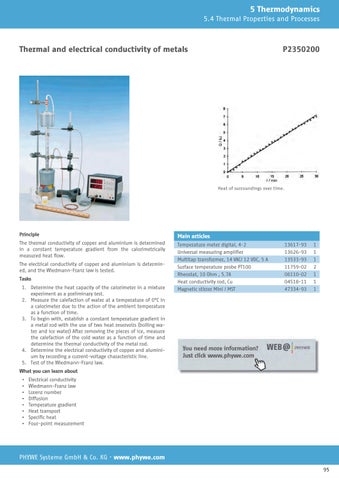5 Thermodynamics 5.4 Thermal Properties and Processes
Thermal and electrical conductivity of metals
P2350200
Heat of surroundings over time.
Principle
Main articles
The thermal conductivity of copper and aluminium is determined in a constant temperature gradient from the calorimetrically measured heat flow.
Temperature meter digital, 4-2 Universal measuring amplifier Multitap transformer, 14 VAC/ 12 VDC, 5 A Surface temperature probe PT100 Rheostat, 10 Ohm , 5.7A Heat conductivity rod, Cu Magnetic stirrer Mini / MST
The electrical conductivity of copper and aluminium is determined, and the Wiedmann-Franz law is tested. Tasks 1. Determine the heat capacity of the calorimeter in a mixture experiment as a preliminary test. 2. Measure the calefaction of water at a temperature of 0°C in a calorimeter due to the action of the ambient temperature as a function of time. 3. To begin with, establish a constant temperature gradient in a metal rod with the use of two heat reservoirs (boiling water and ice water) After removing the pieces of ice, measure the calefaction of the cold water as a function of time and determine the thermal conductivity of the metal rod. 4. Determine the electrical conductivity of copper and aluminium by recording a current-voltage characteristic line. 5. Test of the Wiedmann-Franz law.
13617-93 13626-93 13533-93 11759-02 06110-02 04518-11 47334-93
1 1 1 2 1 1 1
What you can learn about ▪ ▪ ▪ ▪ ▪ ▪ ▪ ▪
Electrical conductivity Wiedmann-Franz law Lorenz number Diffusion Temperature gradient Heat transport Specific heat Four-point measurement
PHYWE Systeme GmbH & Co. KG · www.phywe.com 95
